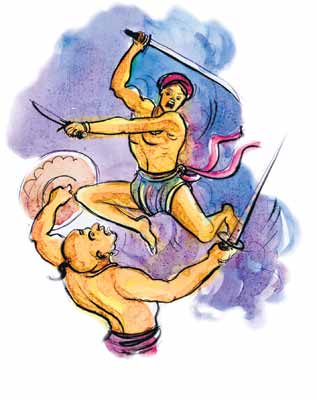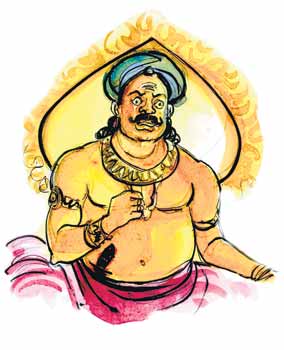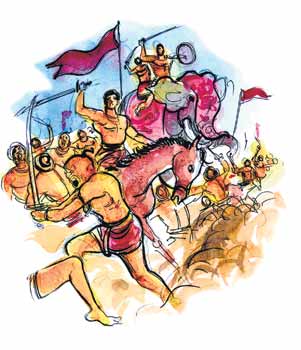
| This article is part of a continuing series on the 'Mahavamsa,' the recorded chronicle of Sri Lankan history The battle at Matota
1. The Chola commander was quite taken aback, noticing the awakening of the Sinhala people. He realized that it was difficult to suppress it. The security of the fortress was tightened immediately. Everybody was told about the gravity of the situation. He ordered his men to store enough food supplies. In short, plans were made for a battle that would go on for a long period of time. Soldiers were constantly given training, to be in readiness. Whatever strategies that could be adapted, were seen to. He was observing the situation. 2. While all this was taking place in the Chola camp, villages, hamlets and colonies were all aroused by a new wave of patriotism. Great was the unity of the Sinhala people of the time. King Vijayabahu too was on his way to Polonnaruwa amidst the blessings of the people. A large number of soldiers accompanied him. On their way, they managed to destroy little fortresses and watch huts erected by the Cholas. They were burnt. The Cholas who were stationed at these centres fled to Polonnaruwa.
3. The king and the soldiers who accompanied him took the old route. They crossed the river and stopped at the Miyuguna Chetiya. They held a religious ceremony there. Pirith was chanted and all the soldiers shared the blessings. This helped to further uplift their morale. There they took an oath to the effect that, "this battle is not for any personal gain, but for the sake of the country, the nation and the religion." They stayed there for a couple of days. 4. By this time, the army that went along the Eastern coast was at Matota. Matota was one of the Chola strongholds. Here the Sinhala army began to attack. Cholas were getting foreign armies too, through Matota. There was a large army there. Disregarding the strength of the Chola army, the Sinhala soldiers began to fight. The Cholas too were brave and powerful. They were well-prepared to face any attack. So the fighting went on. 5. However large the Chola army was, it did not take long for them to get weakened. As the Sinhala army was almost fanatical, they fought with all their might. When the Cholas were retreating too, they chased and attacked them. Thereby they managed to defeat the enemy. They hoisted the Sinhala flag at Matota. It was after 1029 AD, that Sinhala power was established there. The news of these victories reached King Vijayabahu. His army too, advanced and conquered the barrier at Muhunnarugama.
6. The Chola fortress at Badalathala and Venaru, were annexed in quick succession. Advancing further, Thalagula, Managala and Madagala, which were pockets of Chola power were all conquered. In all these places, the Sinhala residents helped the Sinhala army in whatever way they could and wished them success. As all the Chola soldiers who were stationed at different centres flocked to Polonnaruwa, the Chola power at Polonnaruwa increased. 7. Encouraged by the large numbers, the Chola commander thought of attacking the Sinhala army that came from the East. But, by that time, even the army that came from Mayarata, had almost reached Polonnaruwa. Not knowing this, the Chola army attacked the Sinhala soldiers who came from the East. They fought back. As the Sinhala army that came from Mayarata too joined in the fighting, things became difficult for the Cholas. The Cholas became helpless. 8. They retreated to their camp at Polonnaruwa and decided to confine themselves to the camp. Most of their clever warriors had died in battle. The Cholas now realized that at any moment the Sinhala army would attack their camp and kill them all.
|
|| Front
Page | News | Editorial | Columns | Sports | Plus | Financial
Times | International | Mirror | TV
Times | Funday
Times|| |
| |
Copyright
2007 Wijeya
Newspapers Ltd.Colombo. Sri Lanka. |


